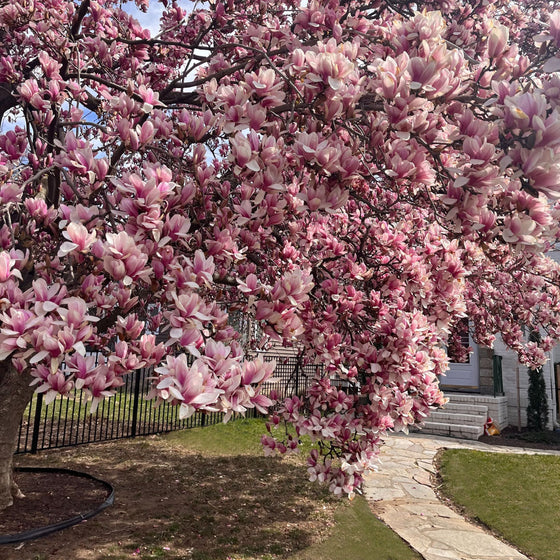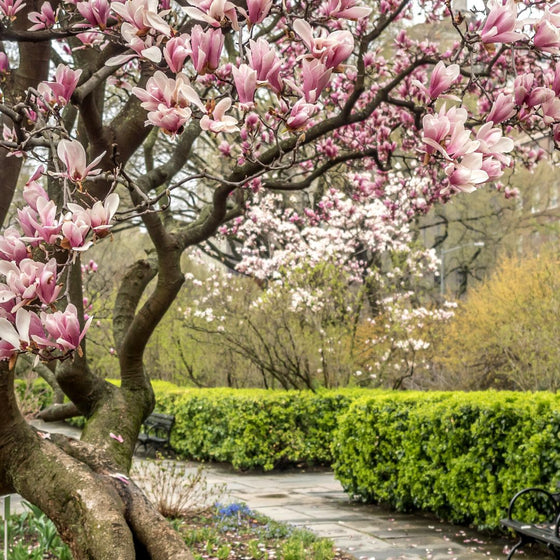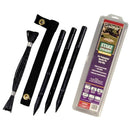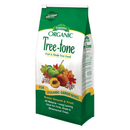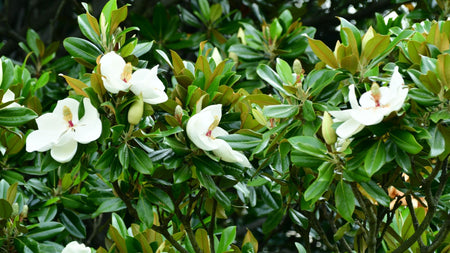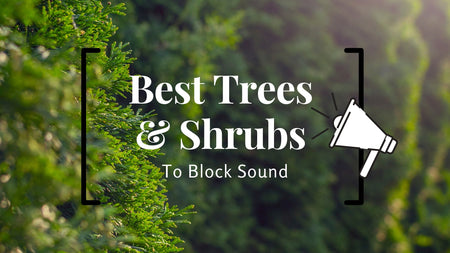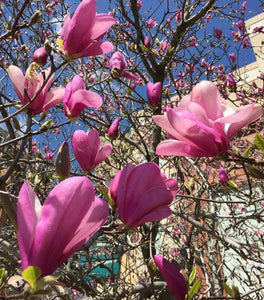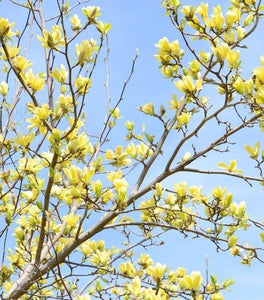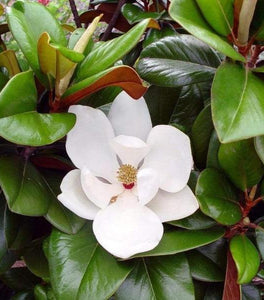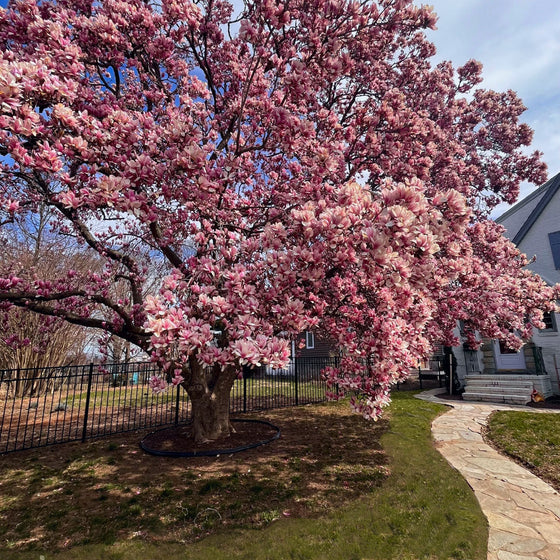
Images Depict Mature Plants
Saucer Magnolia Trees for Sale Online
Magnolia Trees are a long-time favorite when it comes to choosing a blooming specimen for spring and summer landscapes.
After fifteen years of breeding, a new Magnolia the Saucer Magnolia has been created. The Saucer is a reblooming tree that boasts showy deep maroon-purple tulip-shaped blooms.
Beyond the gorgeous blooms that appear in spring and then again in summer, these deciduous trees are loved for their small pyramidal form. The hardy trees, though small are incredibly eye-catching and make a great option as a focal point for an outdoor space.
Ideal conditions for these saucer magnolias include slightly acidic well-drained soils and conditions of full sun to part shade. These trees are not only compact and easy to manage, but they are also tolerant of a range of conditions once established.
These trees are great for impatient gardeners, as, unlike many young trees the Genie Magnolia produces flowers at a young age! For best results, we recommend you plant Magnolias when dormant in late fall or winter in warmer climates. and in early spring in cooler climates.
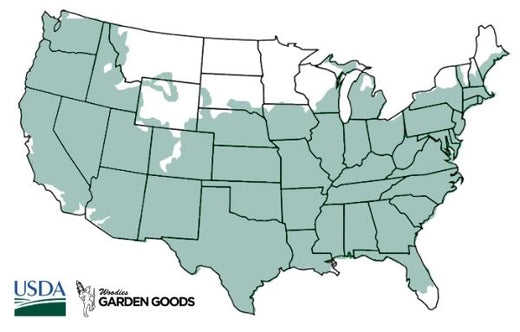
| Hardiness Zone: | 5-9 |
|---|---|
| Mature Height: | 10 to 15 Feet |
| Mature Width: | 10 to 13 Feet |
| Classification: | Broad leaved deciduous small tree, spring flowering |
| Sunlight: | Full sun to part shade |
| Habit: | pyramidal form |
| Foliage: | Dark green, yellow to bronze fall color |
| Flower Color: | Rosy Pink |
| Pruning Season: | No pruning needed |
| Soil Condition: | Any well drained soil |
| Water Requirements: | Water well until established |
| Uses: | Tolerates moist soil and full sun. Full sun brings out the best fall color. Will adapt to drier sites. |
How to Care for Saucer Magnolia
Be sure to read about the recommended care instructions to keep this plant healthy and thriving for years to come!
How do I water the Saucer Magnolia?
After back filling and lightly compacting the 50/50 mix of existing soil and compost give the Saucer Magnolia a good deep watering. This is not to be rushed. Most of the water you put on the plant at first will run away from the plant until the soil is soaked. A general rule of thumb is to count to 5 for every one gallon of pot size. For example a one gallon pot would be watered until you count to 5 a three gallon pot would be 15 and so on. Check the plant daily for the first week or so and then every other day there after. Water using the counting method for the first few weeks. Gator Bags are a good investment that will help minimize the watering chore.
How do I mulch Saucer Magnolias?
We highly recommend that you mulch your Saucer Magnolia with either a ground hardwood mulch or a ground cypress mulch depending on your local availability. Any type of mulch will do but cypress or hardwood mulch will be of a higher quality and provide better nutrition overall as they breakdown. Mulching helps to keep weeds away which will compete with your new investment for water and nutrients. A 2 to 3 inch layer of mulch is sufficient but remember to take care not to cover any part of the stem of the plant with mulch. It's better to leave a one inch gap of space between the mulch and the stem or trunk of the plant.
How do I plant my Saucer Magnolia Tree?
We suggest when planting your newly purchased Saucer Magnolia that you dig a hole twice as wide as the root system but not deeper. Depending on the quality of your existing soil you may need to add a locally sourced compost or topsoil to the back-fill soil. We do not recommend using straight topsoil or compost as a back-fill soil because more times than not these products will retain entirely to much moisture and will cause the root system to rot. Adding compost or topsoil will help the young feeder roots of Saucer Magnolia to spread through the loose, nutrient rich soil, much easier than if you used solely the existing soil which more times than not will be hard and compacted. The most common cause of plant death after transplanting is planting the new plant to deep. That is why we do not recommend planting in a hole any deeper than the soil line of the plant in the pot. A good rule is that you should still be able to see the soil the plant was grown in after back-filling the hole.
How do I fertilize Saucer Magnolias?
Trees such as Saucer Magnolias grow best if they are fertilized lightly in the spring once frost has passed with a well-balanced, extended-release fertilizer such as Espoma Tree-tone. Fertilize Saucer Magnolias again 6 to 8 weeks later to encourage denser foliage or faster growth of young trees. We recommend Bio-Tone fertilizer when planting. Either chemical fertilizers or organic matter can be used successfully with Saucer Magnolia. Since an organic method of applying manure and/or compost around the roots, produces excellent results and also improves the condition of the soil, this would be an excellent first line of attack. Organic additions to the soil can also be combined with a shot of chemical fertilizer for maximum effect. If chemical fertilizers are used on your Saucer Magnolias, applying a slow-release, balanced fertilizer once a year is probably the simplest solution. Don't fertilize Saucer Magnolias after August. Fall is the time for plants to begin preparing for dormancy. Fertilizing at this time may stimulate new growth that will be too tender to withstand the winter. In the South, a late May application and another in July would be about right. More northern areas may wish to fertilize only once in June or July.


